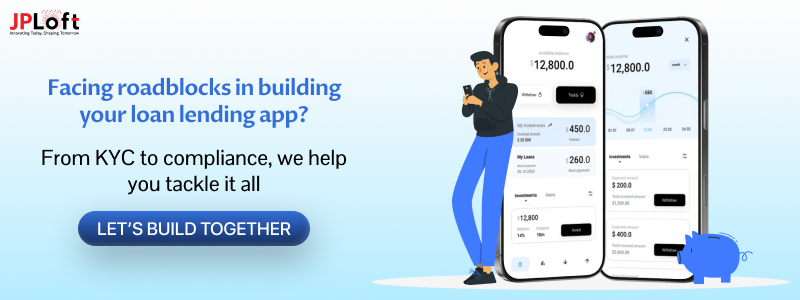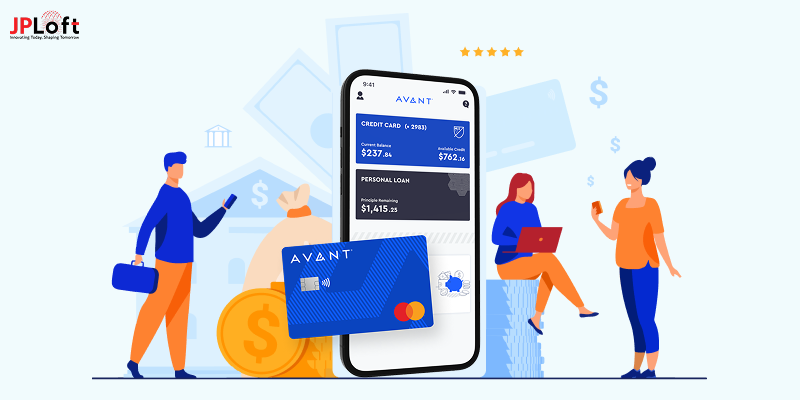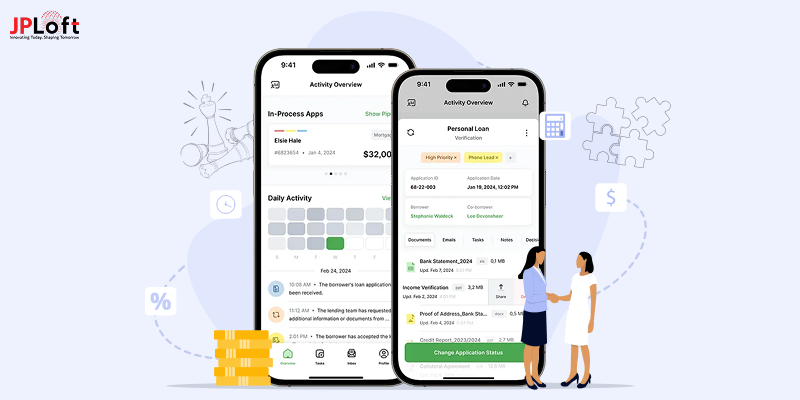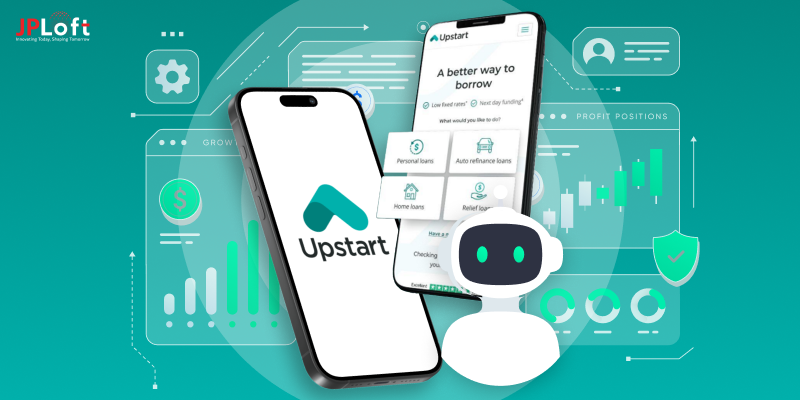Loan apps are changing the money game.
People don’t wait in lines anymore; they tap, verify, and boom,loan approved.
The digital lending market is booming.
It’s set to cross $20.5 billion by 2026. That’s a lot of loans.
Users want speed. Fintechs want scale.
But the journey from idea to app store? Not so simple.
Behind every sleek app is a maze of rules, risks, and real-time decision-making.
KYC checks. Data security. Regulatory chaos. Each step feels like solving a Rubik’s cube, with a timer on.
If you're thinking of building one, you're in for a smart, wild ride. Let’s break down the challenges while developing money lending apps and how to outsmart it.
Overview of Loan Lending App
Loan lending apps have transformed how people access short-term credit, no more paperwork, waiting in lines, or rigid bank processes.
With just a few taps, users can apply for and receive funds in minutes.
Among the most popular are one-time cash advance apps, which offer quick financial relief for emergencies, bills, or urgent expenses without lengthy approval processes.
These apps appeal to a growing audience that values speed, transparency, and convenience.
Behind the scenes, however, developing such platforms involves building intelligent systems that automate risk assessments, verify identities, and ensure data security.
The goal is to deliver a seamless experience while staying compliant with financial regulations.
From credit scoring models to repayment tracking, every feature needs to work flawlessly to win user trust and scale effectively.
As digital lending continues to grow, apps that combine smart technology with user-first design are shaping the future of borrowing.
Loan Lending App Market Stats
Planning to create a loan lending app? The numbers will make you want to start today.
-
- The global digital lending platform market was valued at $10.55 billion in 2024 and is projected to grow at a rapid CAGR of 27.7% between 2025 and 2030.
- Most users expect approval times under 10 minutes; speed and UX are game-changers
- Meanwhile, the U.S. digital lending space is evolving fast.
.webp)
These loan lending app trends highlight one thing: the demand is truly amazing, but so is the pressure to build it right.
This is why you need to explore different loan lending app market stats. Think fast, build smarter, and let’s explore in the next section what stands in your way.
Top Loan Lending App Development Challenges & Their Solutions
Building a loan lending app sounds like an exciting opportunity in the booming fintech industry.
After all, millions of people are looking for faster, more convenient ways to borrow money.
But while the demand is soaring, loan lending app development challenges can be a tough nut to crack.
From ensuring compliance with ever-changing regulations to developing seamless user interfaces, the road to a successful money lending app can be filled with bumps.
Let’s explore the top challenges in loan lending app development and dive into actionable solutions that will help you turn these hurdles into stepping stones for your success.
1. Compliance with Regulations and Legal Framework
One of the biggest loan lending app development challenges is navigating the complex and evolving regulatory landscape.
Every country and region has its own set of rules for digital lending, which can make developing a successful money lending app a compliance nightmare.
Solution:
Before you start a money lending business, stay updated with local, national, and international lending laws, and work with legal experts to ensure your app is compliant.
Consider building a regulatory framework into your app to automatically update legal requirements, making the process smoother.
Additionally, integrating Know Your Customer (KYC) and Anti-Money Laundering (AML) protocols ensures that you stay on the right side of the law.
These features verify the identities of users to reduce the risk of fraudulent activities.
2. Security and Data Privacy Concerns
In the world of loan lending app challenges, data privacy and app security top the list.
With sensitive financial data being exchanged and stored, ensuring that your app is secure from cyberattacks and data breaches is essential.
Users want to feel safe when using financial services, and a single security breach can tarnish your app’s reputation.
Solution:
Implement advanced encryption techniques (like SSL, end-to-end encryption) and multi-factor authentication to keep data safe- this is where the cost to develop a loan lending app spikes, but cuts corners at your peril.
Also, conduct regular penetration testing to identify vulnerabilities and address them before they become major threats.
Adopting data anonymization and secure cloud storage will further protect user information and ensure that personal data is only accessible by authorized parties.
3. High User Expectations for Speed and Simplicity
Modern users have grown accustomed to instant gratification, especially in loan lending app development.
The need for fast loan approvals is a top loan lending app development challenge, as a significant percentage of borrowers expect decisions within minutes, not hours.
Solution:
To meet these expectations, streamline your loan application process and make it as user-friendly as possible.
Use AI-based credit scoring models to speed up approval processes by automatically assessing a borrower’s creditworthiness.
Additionally, provide users with an intuitive interface that simplifies the loan application and management process.
Another idea? Implement real-time notifications to update users at every stage of their loan request. This keeps them engaged and reassured.
4. Risk Assessment and Credit Scoring
Determining the creditworthiness of a borrower is one of the biggest challenges in developing a loan lending app.
Leverage the role of AI in loan lending to analyze alternative data points like transaction history, social behavior, and mobile usage. AI-driven models improve accuracy and speed up approvals.
Traditional credit scores often don’t provide an accurate picture, especially in emerging markets.
Without the right tools, loan lending app challenges related to risk assessment can severely impact profitability and growth.
Solution:
Leverage the role of AI in loan lending to analyze alternative data points like transaction history, social behavior, and mobile usage. AI-driven models improve accuracy and speed up approvals.
This will give a more holistic view of a borrower’s ability to repay.
Additionally, AI-based credit scoring can evaluate a broader set of financial behaviours and trends.
Machine learning algorithms can be fine-tuned to detect patterns that human agents may miss, making the process faster and more accurate.
5. Managing Loan Repayment Schedules
Once loans are disbursed, ensuring timely repayment becomes a challenge.
Delayed payments can create serious cash flow problems for lenders, and tracking loan repayment schedules manually is both time-consuming and prone to errors.
Solution:
Integrate automated repayment systems into your loan lending app that will allow users to set up recurring payments and send reminders about due dates.
Offering flexible repayment plans, such as weekly, bi-weekly, or monthly options, will make the app more user-friendly. Take inspiration from the best loan lending apps that excel in repayment management
Also, allow users to access detailed loan management dashboards, which will help them keep track of their repayments and any outstanding balance.
Offering an option to restructure loans for users in financial distress can increase trust in your app.
6. Fraud Prevention and Detection
Fraud is a growing concern for lenders in the digital space.
Money lending app development challenges related to fraud include identity theft, fake applications, and unauthorized transactions.
Not detecting these fraud attempts early can lead to significant financial losses and damage to your app’s reputation.
Solution:
Implement fraud detection algorithms powered by machine learning to continuously monitor loan applications and transactions for suspicious activity.
Behavioral biometrics can be used to identify and flag irregular activities in real-time.
Additionally, use blockchain technology to create an immutable record of every transaction, making it much harder for fraudulent activities to go unnoticed.
7. Scalability and Server Issues
As your loan lending app grows in popularity, managing increased traffic and data load becomes a serious concern.
If your servers can’t handle high-volume traffic, your app may slow down or crash during peak hours, frustrating users and affecting your reputation.
Solution:
To avoid performance issues, design your app to be scalable from the beginning. Invest in the right tech stack for loan lending apps (e.g., Kubernetes for auto-scaling).
Use cloud-based platforms such as AWS or Google Cloud, which allow you to scale your infrastructure quickly and efficiently.
Load balancing and microservices architecture can also help optimize app performance and ensure smooth user experiences.
Regularly monitor your servers and databases to ensure they can handle spikes in traffic, particularly during high-demand periods like holiday paydays day.
8. User Trust and Engagement
User retention is a constant challenge in the fintech space.
Building trust with users is crucial, as borrowers need to feel that their money and personal data are in safe hands. Without trust, your loan lending app is unlikely to gain traction.
Solution:
Transparency is key. Provide users with clear information about loan terms, interest rates, and repayment schedules.
Use reviews and ratings to show new users that your app has a strong, satisfied customer base.
Regularly engage users through personalized communication, offering them tailored financial advice, loan products, or updates on loan statuses.
Create a loyalty program where users who consistently repay on time are rewarded with lower interest rates or better loan terms.
9. Customer Support and Experience
Providing excellent customer support is essential, but it’s also one of the most challenging aspects of loan lending app development.
Users need help with everything from understanding loan terms to troubleshooting technical issues.
Solution:
Integrate amazing money lending features like live chat or chatbot that provides 24/7 assistance.
Use AI-powered support tools to answer frequently asked questions instantly, reducing the load on human agents.
Additionally, offer multiple support channels such as phone, email, and social media, and ensure your support team is well-trained to handle all inquiries promptly and professionally.
10. Integration with Third-Party Systems
Most loan lending apps require integration with third-party services, such as payment gateways, banking systems, and credit bureaus.
This can lead to challenges related to compatibility, system synchronization, and security.
Solution:
Ensure that your app architecture supports seamless third-party integration.
Choose API-first development to simplify the integration process and ensure that your app can easily connect to multiple external systems.
Test all integrations thoroughly before launch and ensure that data exchanges between your app and third-party services are secure and encrypted.
Knowing these hurdles isn’t enough; you will also need a top mobile app development company in Denver by your side to overcome them, which is what our next section is about.
How JPLoft Turns Loan Lending App Challenges into Fintech Success Stories?
Every second, someone taps a screen, hoping to get a loan approved. Behind that tap? Complex tech, tight regulations, and razor-thin trust margins.
Building a loan lending app isn't just about speed; it's about getting everything right under pressure.
That’s where the right development partner changes the game.
From detecting fraud before it happens to building AI engines that approve loans in minutes, we’ve seen and solved it all. Real-time scoring? Done. Scalable architecture that doesn’t crash on payday? Nailed it.
At JPLoft, as a top loan lending app development company can turn these challenges into amazing digital experiences.
With over a decade of hands-on fintech expertise, we don’t just deliver apps, we launch fintech platforms built for speed, scale, and security.
Ready to turn your loan app idea into a success story? Let’s build it.
Conclusion
Building a successful loan app takes more than just an idea; it demands strategy, compliance, and top-tier execution.
From risk assessment to real-time payments, the challenges in creating a loan-lending app are real, but so are the solutions.
By understanding and addressing each of the top loan lending app development challenges, you position your business to deliver faster, safer, and more reliable digital lending experiences.
Partnering with the right tech team can make all the difference.
The future of lending is digital. Are you ready to lead it?
FAQs
Some of the key loan lending app challenges include regulatory compliance, data security, fraud detection, scalability, and integrating third-party APIs like credit bureaus or payment gateways.
Stay updated with local regulations, implement KYC/AML protocols, and consult with legal and fintech experts. Building a flexible regulatory framework is essential.
Modern users expect approvals in minutes. A smooth, fast, and intuitive user experience directly impacts conversions, trust, and app retention.
AI enables faster credit scoring, fraud detection, and personalized user experiences. ML models help make smarter, data-backed lending decisions in real-time.
JPLoft offers secure, scalable, and custom fintech app solutions. With deep domain expertise, we help you overcome all loan lending app development challenges from idea to execution.













Share this blog